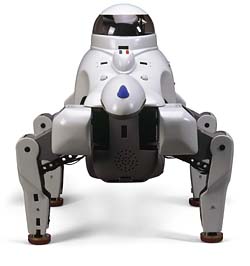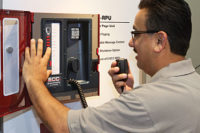
Lee and Karen Wood, owners of Plumbing Plus, a Roto Rooter independent contractor, believe in new-age monitoring. They sought out an alternative monitoring service to solve a business-threatening problem: concern about the efficiency and on-time location of in-the-field employees and trucks. The solution: automatic vehicle location driven through an off-shelf paging service.
And University of Utah students, living in campus residents, feel better-protected thanks to unique monitoring of in-house fire extinguishers. The extinguishers are remotely monitored for pressure, presence and obstruction to access.
Welcome to the next steps in monitoring. Such services, whether provided by a dealer, central station or alternative source, now go successfully beyond burglar and fire alarms. Of course, they always have. Levels of carbon monoxide are remotely monitored. Security firms and central stations routinely monitor process controls, environmental conditions, water level, vending machines and computer conditions. For more than two decades, there has been a business in personal, home monitoring made famous with the advertising phrase “I’ve fallen and can’t get up.â€
Things haven’t as much changed as expanded.
Some advances extend into specialty end user areas such as school security.
An example: Honeywell Building Solutions of Minneapolis just unveiled what the firm calls the Honeywell Instant Alert for Schools. The automated emergency notification and communication system enables schools to instantly broadcast information about an emergency situation to parents and guardians through the communication devices of their choice.
This fall, ADT Security Services of Boca Raton, Fla., started talking up its InterACT service. Using existing video surveillance cameras coupled with broadband transmission, InterACT can broadcast real-time voice and video images to ADT’s central monitoring stations.
Independent dealers wishing to enter the interactive video monitoring market can work through a handful of central stations.
For instance, Irvine, Calif.-based NACC (National Alarm Computer Center) has increased its focus on turnkey interactive video monitoring or IVM programs for dealers. Steve Baker, president of NACC, points out that “IVM programs are designed to help enhance a dealer’s effectiveness in being able to monitor the field, potentially resulting in stronger margins and increased customer retention.â€

Another emerging opportunity for monitoring embraces location-based services (LBS).
Dr. Stephen Colwell, president C3 Location Systems of Boca Raton, Fla., feels that popular applications for LBS can decrease end user transportation and manpower costs, their customers’ wait time for deliveries and, in the consumer markets, provide new platforms of security, roadside assistance and safety. “From fleet tracking to emergency medical alerting the central station can capture new revenue streams in this burgeoning new market,†he says.
Powerful central station software, according to Dr. Colwell, is one key element in building a successful LBS business. The other critical component: global positioning system devices.
Plumbing Plus adopted Teletouch’s TT AVL automatic vehicle locater. The Tyler, Texas, firm’s systems use global positioning satellites and either the cellular network or a satellite network to help monitor and track vehicles, detached trailers and any other mobile asset.
HomMed LLC of Brookfield, Wis., for instance, has a growing business working with hospitals, healthcare facilities and home installers to provide specialty telehealth monitors. Such technology goes beyond tracking a person; it establishes an intervention system that identifies and reacts to the potential problems associated with chronic illnesses and other health conditions.
Another monitoring twist is how such services are including coverage of unique life safety assets for the first time.
In a unique breakthrough earlier this year, Rockland, Mass.-based MIJA, Inc., showed dealers and installers its EN-Gauge.
By electronically monitoring fire extinguishers for pressure, presence, and obstruction to access, the technology can help prevent property damage and danger to lives by ensuring that every time an extinguisher is needed, it is where it is supposed to be and fully operable.
Sidebar: Robot Monitors
A number of Japanese government and private business teams are improving robots for entertainment, home services and security monitoring applications.Matsushita Electric Industrial, Hitachi, Sony, Sharp and other firms are hard at work on a diversity of home support approaches. One idea: give every device in the home – from a PIR to a light
fixture – an Internet Protocol or IP address.
Among the wildest concepts: intelligent, always moving robots that collect myriad data - through sensors, detectors, video cameras, microphones - to monitor the environment.

Sidebar: Monitoring and Homeland Security
Traditional security firms, military contractors and niche tech new faces are all working on ways to integrate monitoring into the homeland security fabric.Just last month, San Diego-based Satellite Security Systems (S3), a provider of asset security and logistics control, working with the California Highway Patrol and the InterState Oil Company, demonstrated the first wireless remote shutdown of a fully loaded moving petrochemical tanker truck.
From S3’s headquarters, satellite communications disabled the truck, using S3’s GlobalGuard and FleetGuard systems.




